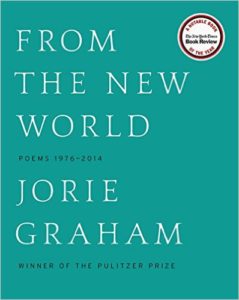From the New World, Poems 1976 –2014
 by Jorie Graham,
by Jorie Graham,
Ecco / HarperCollins Publishers, 2015,
384 pages, cloth, $29.99,
ISBN 9780062315403
Buy the Book
This is the heat that seeks the flaw in everything
and loves the flaw.
— Jorie Graham
In 1923, Marcel Duchamp referred to his work, The Bride Stripped Bare by her Bachelors, Even as a “delay in glass,” much like a “poem in prose” or a “spittoon in silver.” Suspicious of words and yet enamored with them too, Duchamp literally suspended an image in space and time; creating a “delay” — of arrival, of meaning, in relationship to representation, in relationship to an “indecisive reunion” as Calvin Tomkins named it in 1996. The amount of time you wait for something that is held back, a period of time in which something is postponed or slowed down, this delay in Duchamp’s work, as in the poet Jorie Graham’s, creates the conditions of desire.
The occasion of Graham’s new selected poems, From The New World, Poems 1976 – 2014, tracking nearly four decades of the Pulitzer Prize winner’s work, provides an eloquent opportunity to regard the specific obsessions and investigations, and the aesthetic and ethical development, of her work. The collection creates a new trajectory through her eleven volumes, and is rife with “delays” of the best kind: gaps and lulls and flaws that seek mending or to be knit, that seek connection and dialogue. Graham moves from using language to describe delay and its accompanying desire in her early work, toward creating the conditions of a delayed arrival for her reader in the structure of the poems themselves in later work. The later poems elicit a breathless haste in their desire to arrive at new meaning.
An early poem, the third in this collection, “The Geese,” from her first book Hybrids of Plants and Ghosts, takes place in a yard in Murray, Kentucky, where the speaker is hanging out wash beneath the migrations of geese, while spiders imitate the paths of the geese above “to no avail: / things will not remain connected, / will not heal.” In this gesture, “the world thickens with texture instead of history, / texture instead of place” and the longing to connect is a desire to help things “recover their meaning”:
There is a feeling the body gives the mind
of having missed something, a bedrock poverty, like falling
without the sense that you are passing through one world,
that you could reach another
anytime. Instead the real
is crossing you,
your body an arrival
you know is false but can’t outrun. And somewhere in between
these geese forever entering and
these spiders turning back,
this astonishing delay, the everyday, takes place.
In many of Graham’s poems throughout her oeuvre, the shuttle moves back and forth across these kinds of delays; the poems are filled with metaphors of weaving, stitching, and sewing, making a fabric of the page we navigate and the ideas and images she provokes. For example, in “Girl at the Piano,” the speaker says of the daughter:
. . . Your sleep beside me is the real,
the loom I can return to when all loosens into speculation.
Silently, the air is woven
by the terribly important shuttle of your breath,
the air that has crossed
your body retreating, the new air approaching.
In the poem, “Self Portrait as Hurry and Delay (Penelope at Her Loom),” from Graham’s third collection, Penelope enacts delay as a strategy for fending off suitors, weaving and unweaving the story cloth daily, doing and undoing, effectively suspending time, and holding the story — her life — in place. The poem unfolds in a series of twenty-three numbered sections that provide occasion
for breath within the poem, pauses within the unfolding narrative. They also begin to employ a layering technique that becomes more nuanced in Graham’s work over time, creating a stratigraphy and accumulation of meaning. In this poem, she begins to ask readers increasingly to fill in the gaps, to enter the text and engage the delays, to engage in the stitching and unstitching themselves. Graham asks, “Oh but is it wide enough to live on, immaculate present tense, lull / between wars, // the threads running forwards yet backwards over her stilled fingers,” and later, “Yet what would she have if he were to arrive?”
“Le Manteau de Pascal,” the poem at the center of her sixth book, The Errancy, and located at the center of this new collection, regards René Magritte’s 1957 painting of Pascal’s coat, the Surrealist image of a coat full of holes hovering in the night sky above a distant urban horizon. In the endnotes Graham says, “One presumes it represents the coat in which Pascal was buried, and in whose hem or sleeve or ‘fold’ the note containing the ‘irrefutable proof of the existence of God’ is said to have been stitched at his request, unread, by his sister upon his death.” This poem, too, unfolds in a series of sections, including excerpts from Hopkins’s journals and Magritte’s notebooks. The breaks between sections, and the leaps in content and meaning, again create the conditions for great intimacy and exchange within the text. As Graham notes, “The sky can analyze the coat because of the rips in it. // The sky shivers thought the coat because of the rips in it. // The rips in the sky ripen through the rips in the coat. // There is no quarrel.”
The final page and a half of this poem are tightly packed with phrases previously uttered in the eight-page poem. Through this sudden dense layering of lines, an accumulation and acceleration through material investigated before, a kind of “learning” occurs for the reader that creates an uncanny experience of déjà vu. Increasingly, Graham’s poems illicit a breathlessness as they careen toward their end, layer upon layer, at times creating a sort of panicked haste, a desire to encounter meaning, to arrive, to become “real.” As the poem ends, she notes, “ . . . floating in the air before us with stars a test case . . . I saw clearly the impossibility of staying.” The poem draws tightly in on itself like a jacket, across the gaps and holes, but the wind — the sky, the reader — can still move through it.
Acceleration in the poems is created through techniques such as listing and anaphora, and structurally, through the shape the poem takes on the page. Towards the end of this collection, the poem “Lull” creates a visual stratigraphy composed of long phrasal layers interspersed with a “core sample” of very short lines that run through the right side of the poem. Navigating both the horizontal of extended thought and the penetrating depth of rapidly moving, layered short lines, the poem deftly navigates the forest’s edge where a fox has come out into the open and stares at the speaker. The speaker contemplates “the dream / of ownership”; “How much / did you think you / could own,” the poem asks. The fox replies as the world is given voice in Graham’s poems:
— fox says
what a rough garment
your brain is
you wear it all over you, fox says
language is a hook you
got caught,
try pulling somewhere on the strings but no
they are all through you,
had you only looked
down, fox says, look down to the
road and keep your listening
up, fox will you not
move on my heart thinks checking the larder the
locks fox
says your greed is not
precise enough.
Through all the poems, there is an impulse to look with greater precision, deeper and longer, to not look away, but to engage war, climate change, our mortality, our gods and, too, to question our very presence on the planet. In this dialogue — this discourse — between self and other, real and metaphor, between known and unknown, history and the present, between fox and heart, geese and spiders, there is a constant desire for connection and to stitch together meaning, some kind of a garment we can wear, even if full of holes. And that garment seems to be made of language. Graham reminds us that this dialogue is where we connect, after all, and that “desire / is the honest work of the body, / its engine, its wind.”
— Julie Poitras Santos

